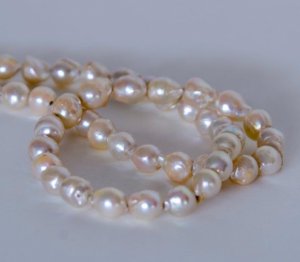- Joined
- Jun 26, 2007
- Messages
- 9,027
I was given a broken strand of akoyas that belonged to a friends mother, who passed away.
They are baroque/pear shaped, about 5-7 mm, and have a really nice pink/green orient.
They look to be quite old and the string was well worn. As I was re-stringing them, It seems that the mother of pearl nucleus in almost every one of them is loose and spins inside the nacre outer covering. How strange! I had to very delicately rotate each nucleus to line up the drill holes, to restring them. Has anyone ever seen this? Why would the nacre separate from the nucleus like that? What do you think?
They are baroque/pear shaped, about 5-7 mm, and have a really nice pink/green orient.
They look to be quite old and the string was well worn. As I was re-stringing them, It seems that the mother of pearl nucleus in almost every one of them is loose and spins inside the nacre outer covering. How strange! I had to very delicately rotate each nucleus to line up the drill holes, to restring them. Has anyone ever seen this? Why would the nacre separate from the nucleus like that? What do you think?








300x240.png)